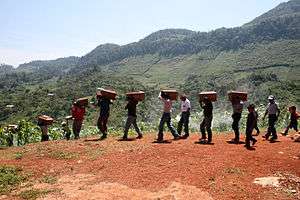Ixil Community
The Ixil Community is a name given to three neighbouring towns in the Quiché department in the western highlands of Guatemala.[1] These towns are Santa Maria Nebaj, San Juan Cotzal, and San Gaspar Chajul.[2] The area's population is predominantly of Ixil descent. When viewed on a map, the three Ixil towns appear to form a triangle, because of this, is also named Ixil Triangle.[3]
Culture
Due to its location in the Cuchumatanes mountains,[4] the Ixil Community has remained mostly isolated from the rest of the world. Its people have therefore maintained their traditional culture free from influences of the outside world. Most of the men are farmers, and most of the women are weavers.
The people of the Ixil Community primarily speak the Ixil language.[5] Some villagers speak Spanish as a secondary language.
Turmoil During Civil War

During the Guatemalan Civil War, the Guerrilla Army of the Poor (EGP) used the surrounding mountains as a base of operations.[6] The Guatemalan Army pursued a scorched-earth policy to destroy villages.[1] The villagers of the Ixil Community were caught in the crossfire, and thousands of civilians were killed, tortured, or disappeared.[6][7]
The army's campaign against civilians in this region may have been motivated partially by a desire "to weaken and eventually eradicate Maya culture." Villagers learned not to wear their traditional Maya clothing, because its distinctive appearance made them easy targets.
References
- 1 2 Manz, Beatriz (1988). Refugees of a hidden war: the aftermath of counterinsurgency in Guatemala. SUNY Press. p. 96. ISBN 978-0-88706-676-4.
- ↑ Manz, Beatriz (1988) p.97
- ↑ Argueta, Al (2007). Moon Handbooks Guatemala. Avalon Travel. p. 109. ISBN 978-1-59880-057-9.
- ↑ Argueta, Al (2007) p.150
- ↑ Perera, Victor (1995). Unfinished Conquest: The Guatemalan Tragedy. University of California Press. p. 61. ISBN 978-0-520-20349-5.
- 1 2 McNally, Shelagh (2003). Adventure Guide to Guatemala. Hunter Publishing, Inc. p. 213. ISBN 978-1-58843-347-3.
- ↑ Argueta, Al (2007) p.151